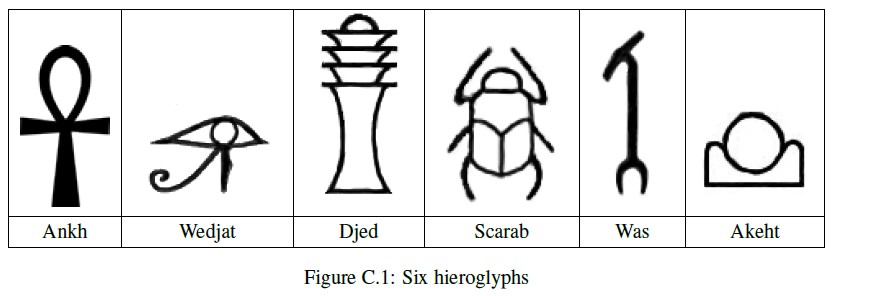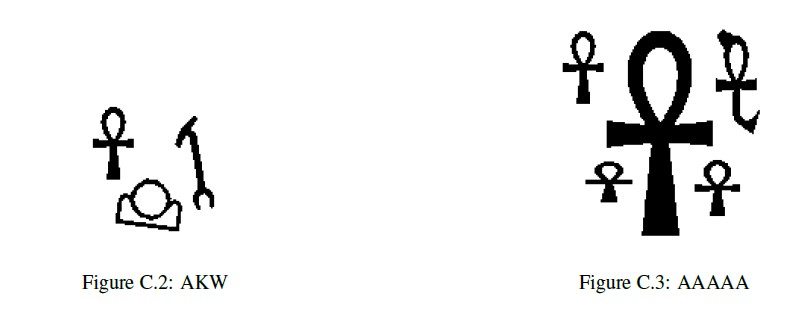标签:


100 25 0000000000000000000000000 0000000000000000000000000 ...(50 lines omitted)... 00001fe0000000000007c0000 00003fe0000000000007c0000 ...(44 lines omitted)... 0000000000000000000000000 0000000000000000000000000 150 38 00000000000000000000000000000000000000 00000000000000000000000000000000000000 ...(75 lines omitted)... 0000000003fffffffffffffffff00000000000 0000000003fffffffffffffffff00000000000 ...(69 lines omitted)... 00000000000000000000000000000000000000 00000000000000000000000000000000000000 0 0
Case 1: AKW Case 2: AAAAA
思路:依据圈的数量来识别。
#include <cstdio>
#include <algorithm>
using namespace std;
char ts[201],mes[6]={'W','A','K','J','S','D'},ans[10];
bool vis[205][205];
int n,m,mp[205][205],nxt[4][2]={{1,0},{0,1},{-1,0},{0,-1}},num;
void dfs(int x,int y)
{
int i;
for(i=0;i<4;i++)
{
x+=nxt[i][0];
y+=nxt[i][1];
if(x>=0 && x<n && y>=0 && y<m && !vis[x][y] && !mp[x][y])
{
vis[x][y]=1;
dfs(x,y);
}
x-=nxt[i][0];
y-=nxt[i][1];
}
}
void dfs3(int x,int y)
{
int i;
for(i=0;i<4;i++)
{
x+=nxt[i][0];
y+=nxt[i][1];
if(x>=0 && x<n && y>=0 && y<m && !vis[x][y] && !mp[x][y])
{
vis[x][y]=1;
dfs3(x,y);
}
x-=nxt[i][0];
y-=nxt[i][1];
}
}
void dfs2(int x,int y)
{
int i;
for(i=0;i<4;i++)
{
x+=nxt[i][0];
y+=nxt[i][1];
if(x>=0 && x<n && y>=0 && y<m && !vis[x][y])
{
if(mp[x][y])
{
vis[x][y]=1;
dfs2(x,y);
}
else
{
vis[x][y]=1;
num++;
dfs3(x,y);
}
}
x-=nxt[i][0];
y-=nxt[i][1];
}
}
int main()
{
int i,j,t,casenum=1,cnt;
while(~scanf("%d%d",&n,&m) && n)
{
n++;
m*=4;
m++;
for(i=0;i<=n;i++) for(j=0;j<=m;j++) vis[i][j]=0;
for(i=1;i<n;i++)
{
gets(ts);
if(!ts[0])
{
i--;
continue;
}
for(j=0;ts[j];j++)
{
if(ts[j]>='a' && ts[j]<='f')
{
t=ts[j]-'a'+10;
mp[i][j*4+1]=t/8;
mp[i][j*4+2]=t%8/4;
mp[i][j*4+3]=t%4/2;
mp[i][j*4+4]=t%2/1;
}
else
{
t=ts[j]-'0';
mp[i][j*4+1]=t/8;
mp[i][j*4+2]=t%8/4;
mp[i][j*4+3]=t%4/2;
mp[i][j*4+4]=t%2/1;
}
}
}
for(i=0;i<=m;i++) mp[n][i]=0;
for(i=0;i<=n;i++) mp[i][m]=0;
n++;
m++;
vis[0][0]=1;
dfs(0,0);
cnt=0;
for(i=0;i<n;i++)
{
for(j=0;j<m;j++)
{
if(mp[i][j] && !vis[i][j])
{
num=0;
vis[i][j]=1;
dfs2(i,j);
ans[cnt++]=mes[num];
}
}
}
sort(ans,ans+cnt);
ans[cnt]=0;
printf("Case %d: ",casenum++);
puts(ans);
}
}
版权声明:本文博客原创文章,博客,未经同意,不得转载。
HDU-3839-Ancient Messages(DFS)
标签:
原文地址:http://www.cnblogs.com/gcczhongduan/p/4635590.html